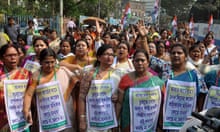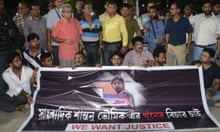Three Indian journalists have been struck by vehicles and killed in recent days in what their families and rights groups claim were deliberate attacks.
The deaths of the reporters Sandeep Sharma in Madhya Pradesh state, and Navin Nischal and Vijay Singh in Bihar state, have underlined India’s status as one of the most dangerous places in the world to be a journalist, particularly in languages other than English and outside large cities.
Sharma, 36, had recently conducted an undercover “sting” that claimed to have produced footage of a senior police official in his area agreeing to accept a 25,000-rupee (£272) bribe each month in exchange for allowing sand mining in a protected crocodile sanctuary.
#WATCH:Chilling CCTV footage of moment when Journalist Sandeep Sharma was run over by a truck in Bhind. He had been reporting on the sand mafia and had earlier complained to Police about threat to his life. #MadhyaPradesh pic.twitter.com/LZxNuTLyap
— ANI (@ANI) March 26, 2018
“After that he was getting lots of threats from people,” said Rizwan Ahmad Siddiqui, editor-in-chief of News World, the local television news channel where Sharma worked.
“He was denied police protection and the police asked for the camera he had used to conduct the sting,” he said. “They took the original recording and never gave it back.”
CCTV footage has been released showing Sharma’s motorcycle disappearing under an accelerating truck on Monday morning on a road in Bhind district, about 310 miles from the state capital, Bhopal.
Police in the district formed a special investigative team and arrested the driver, Ranbir Yadav, on Monday. The Madhya Pradesh chief minister, Shivraj Singh, on Tuesday ordered India’s elite Central Bureau of Investigation (CBI) to investigate Sharma’s death.
News World has been airing segments on Sharma’s death and tributes to the journalist since Monday morning and Siddiqui called for the CBI to also investigate his claims about the illegal sand mining.
Sand is a key ingredient in modern construction and as India rapidly urbanises, the pursuit of the material has been linked to increasing reports of corruption and violence.
The amount of sand used for construction in India has tripled since 2000 by some estimates and supplies around major cities have been depleted. Developers have been travelling to more remote regions to source the material, often bringing them into conflict with communities that complain the dredging process severely damages rivers and coasts.
Organised sand mafias, often alleged to have close ties to authorities, are believed to be involved in most of the illegal extraction, and Reporters Without Borders has noted that journalists “who cover India’s sand mafia are often the victims of violent reprisals”.
“The shocking manner in which Sandeep Sharma was murdered is a terrible warning to journalists who investigate the sand mining mafia phenomenon,” the group said in a statement.
The day before Sharma was killed, Nishchal and Singh were also run down by a vehicle allegedly driven by an ex-village chief, Mohammad Harsu.
Police said on Monday they had arrested Harsu and were investigating the circumstances of the incident.
The pair had finished reporting on a Hindu festival for their publications when they got into an argument with Harsu at a tobacco stand, said Rakesh Kumar Singh, bureau chief of the newspaper Dainik Bhaskar, where Nishchal worked.
“As they were leaving the tobacco stand they were rammed by a car driven by the ex-village head,” Singh said. “[Harsu] used to pressure local journalists to write in his favour and had lots of grudges against these two journalists.”
Singh said journalists in small Indian cities and villages were frequently threatened by local authorities. “These local dons are the big figures,” he said. “If you don’t greet them with a smile you get four slaps. They want you to fear them. They put a lot of pressure on us journalists.”
The Committee to Protect Journalists (CPJ) said in a report last year that 27 journalists had been killed “with complete impunity” in India since 1992. It listed another 25 murders it was investigating to ascertain a connection to the journalists’ work. At least another six journalists have been killed in the time since the report was published.
The CPJ ranks India 13th in its global impunity index, highlighting countries where the murders of journalists are least likely to be punished. The organisation claims not a single journalist’s murder in the country has been solved in the past 10 years.
In September the journalist and editor Gauri Lankesh was gunned down on her doorstep in Bengaluru. Earlier this month police arrested a man with close ties to Hindu nationalist groups.








